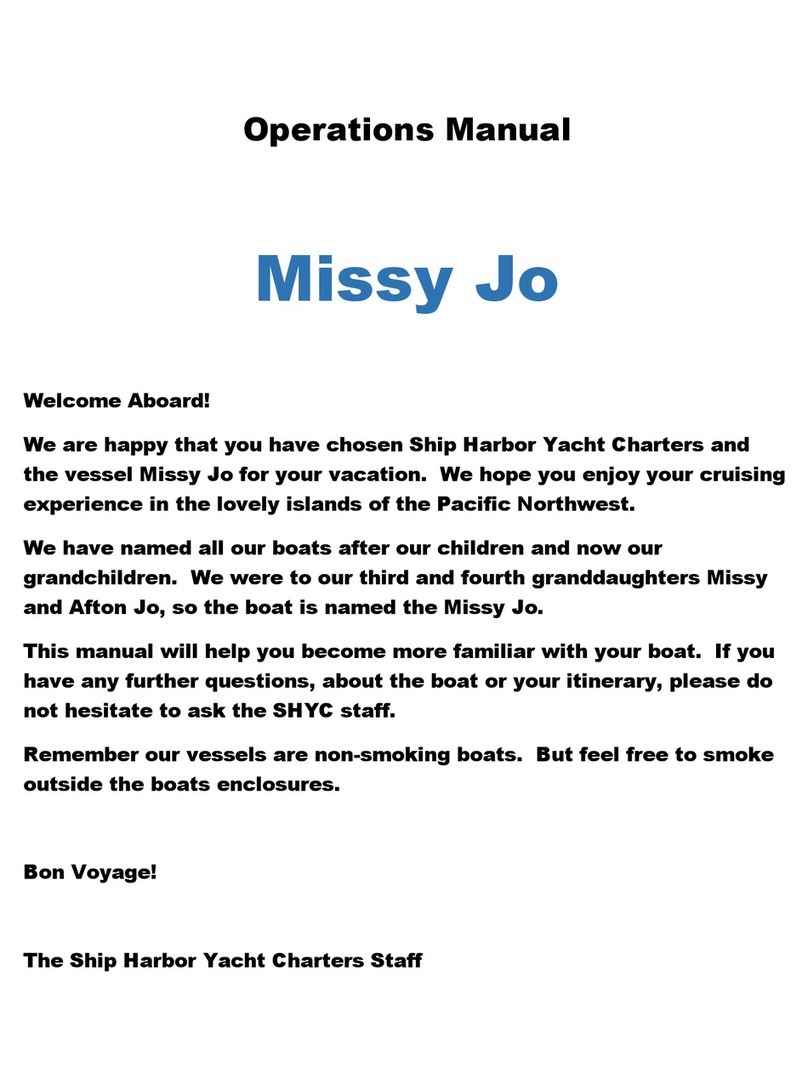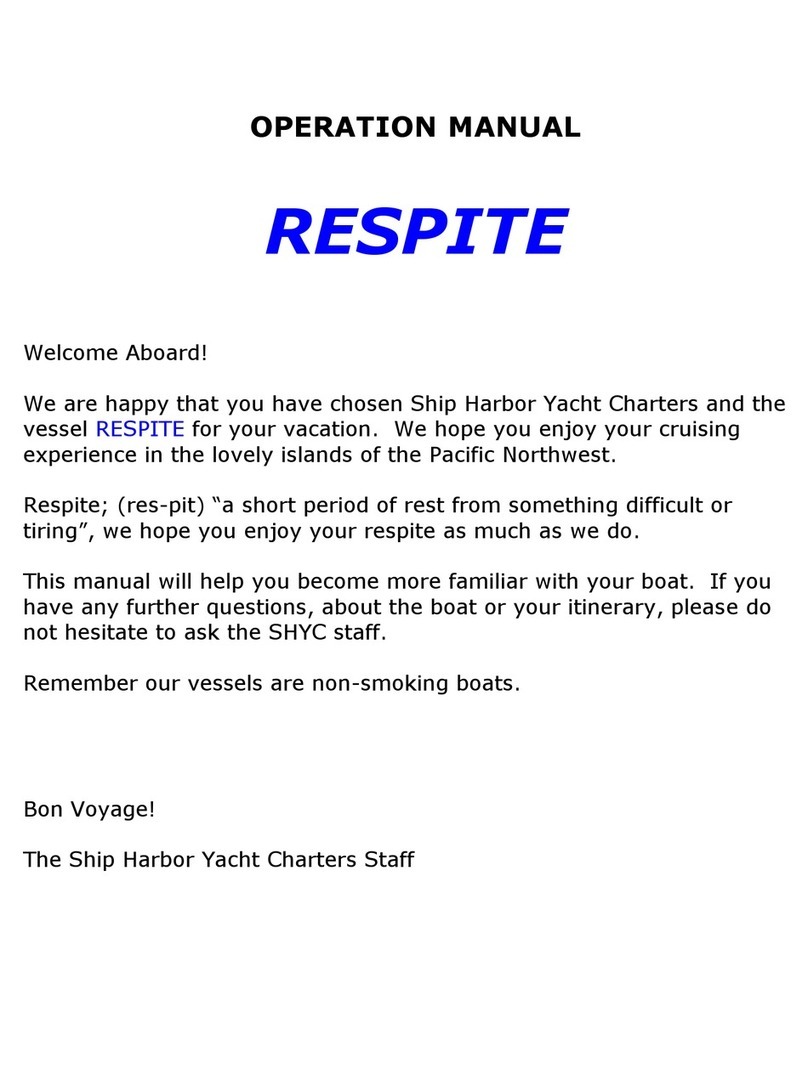Ship Harbor Yacht Charters OHANA User manual

OPERATION MANUAL
OHANA
Welcome Aboard!
We are happy that you have chosen Ship Harbor Yacht Charters and
the vessel Ohana for your vacation. We hope you enjoy your cruising
experience in the lovely islands of the Pacific Northwest.
Ohana, is Hawaiian for Family. Everything on the boat is part of the
Ohana Family.
This manual will help you become more familiar with your boat. If you
have any further questions, about the boat or your itinerary, please do
not hesitate to ask the SHYC Staff.
Remember our vessels are non-smoking boats. But please feel free to
smoke out on deck.
Bon Voyage!
The Ship Harbor Yacht Charters Staff

TABLE OF CONTENTS
Boat Operation Page
Engine Inspection 3
Start-Up
Shutdown
Getting Underway 4
Cruising
Docking
Fueling
Boat Electrical
A.C. (Shore) Power 5
Inverter
D.C. (House) Systems
Batteries
Sanitation System 6
Marine Toilet
Holding Tank(s)
Y-Valve
Water Systems 7
Fresh Water Tanks
Fresh Water Pump
Hot Water
Shower
Galley 7
Propane Stove/ Oven
Refrigeration/ Ice Maker 8
Heating Systems 8
Diesel Heater (DC)
Electric Heater
Electronics 8
VHF Radio, Depth Sounder, Radar
GPS/Plotter
Stereo
Anchoring 8
Sails and Rigging 9
Bar-B-Que 9
Dinghy/ Outboard 9
Other Notes 10
Safety
Crabbing
Dead Heads/ Debris

BOAT OPERATION
Engine Inspection
Remember your “WOBBS” every morning. (Water (Coolant), Oil, Bilges (Inspect and
Pump-out), Belts, and Sea Strainer. Check the level of COOLANT in the expansion
tank. Check the level of your engine oil with the dipstick. Your dipstick is located in
the front of the engine. Look at the etch mark on the dipstick that indicates proper
levels. DO NOT OVERFILL! Fill only if oil levels are below the ½ mark. Check the
general condition of the hoses and belts.
Ensure the RAW WATER THRU-HULL is OPEN! (Lever in-line with valve). Check the
sea strainer for debris. If necessary, close the thru-hull, open the strainer lid, clean
out debris, and reassemble.REOPEN the thru-hull!
Start Up
Ohana has a 75 Turbo hp Yanmar engine with a 3 bladed prop. There is an ignition,
throttle and transmission control in the cockpit. The vessel cruises at ___2800_
rpms to a speed of 7 knots. Running your engine much above that will burn a lot
more diesel at the gain of very little boat speed.
The boat has a definite prop walk to port in reverse with not too much noticeable
effect in forward. When in reverse, be careful to keep a firm grip on the wheel. Use
only low rpms in reverse.
To start engine: Place transmission in the neutral position (usually straight up). If
the engine is cold, first preheat it by pushing the bottom of the 4 buttons for about
15 seconds. Then push the top button (starter button). Your oil and temperature
alarm will sound. There is not a key, Push the starter button; After the engine starts,
warm it up for about 5 minutes at about 1000 rpms. Check the transom for water
and exhaust as an indication that your thru-hull is open and water is keeping your
engine cool.
Do not hold the start button for more than 15 seconds at a time. If the engine does
not catch the first time, wait about 15 seconds before trying again.
After the engine starts, warm it up at about 1000 rpms for about 5 minutes.
Observe your gauge readings. Oil pressure and water temp have warning lights. If
they stay, on stop the engine. Engine temperature should rise very slowly.
Note: If water temp. is high or oil pressure low, shut down engine and look for
problem. Was there a lack of water exiting with exhaust? Are thru-hulls open and
debris cleared from sea-strainer? If problem keeps occurring, call SHYC Service.
Shut Down
Before shutting down, let engine idle for about 5 minutes to cool. Ensure the
gearshift is in the neutral position and the throttle is in idle. Turn off the engines by
pushing the stop button, then the push the ignition button to turn off engine
electrical system.

Getting Underway
Disconnect the shore power cord (see AC Power next page). Close portholes,
windows, and hatches. Turn on VHF and electronics. Assign crewmembers to their
tasks. Put one crew member (the “dingiest” member of course!) in charge of the
dinghy if it is under tow. It needs to be kept on a tight leash when in the marina.
Once outside marina, have crew members bring in fenders and put lines away.
Cruising
Slowly come up to cruising speed of 2200 rpms where you will cruise at approx. 6 ½
knots, using only 3/4 gallons of diesel/hour. Using excessive rpms will only give you
a ½ knot of speed and will only damage the engine. Speed will vary depending on
weight, load, and weather conditions
Docking
During docking, give clear instructions to the crew on what you will expect of them
i.e. with lines and fenders. Always come into the dock slowly allowing for any wind
or tide. If you have a choice, dock on the port side because as you put the
transmission in reverse, she will pull to port sucking you in closer to the dock.
Have the bow, stern, and spring lines ready. If you are short on crew, lead the lines
to the mid section of the boat (where it is fattest) where your crew member can
easily step off with one of the lines, secure it, and quickly grab the next one.
As you are approaching the dock, have your crew call out distances to the captain (ie
20 feet, 10 feet, 3 feet etc.). This will help with a successful landing.
If you find you are too far from the dock, DO NOT have your crew jump! Back out
and do it again. Disaster will follow if someone falls in the water.
Fueling Up
You will need to fill up upon completion of your charter. Your fuel tank holds 58
gallons. You should have a rough idea of the number of gallons you will need to add
to your tank. (i.e. you use 1 gal per hour and have run 18 hours = 18 gal.)
Open the fuel filler cap located on the transom with the key located in the Nav
station or a winch handle. MAKE SURE YOU HAVE DIESEL! Make sure it is going into
the right deck fill! DOUBLE-CHECK! Before pumping, have your oil/fuel sorb ready
to soak up any spilled fuel. Do not add water at the same time.
Put the Diesel nozzle into the deck fitting and pump slowly listening to the sound of
the flow. Pumping too fast may not allow excess air to escape, which will lead to
spillage out the vent. As the tank fills, the sound will rise in pitch or gurgle. Pay
attention to the vent that it does not spill fuel into the water. Top off carefully,
catching any spillage with your sorb.
Check your gauges. Replace the deck fill caps and clean up any spatter and wash
hands thoroughly.

BOAT ELECTRICAL
The electrical system is divided into two distribution systems: 110 volt or AC and 12
volt or DC. The systems are controlled from the electrical panel located above the
chart table and the battery switches are located Port state-room, below the bunk.
When not connected to shore power your batteries provide most of your electrical
power. Therefore, the use of onboard electricity needs to be monitored very
carefully. Turn off electrical devices when they are not being used (lights,
instruments, etc.)
110 Volt or AC (Alternating Current)
Shore Power supports all AC equipment and receptacles on board as well as the
battery charger.
To connect to shore power, plug the power cord into the boat and then into the dock
receptacle. Check your power rating/plug size of the dock receptacle (i.e. 30amp, 20
amp etc.) If necessary, secure the cord around the shore power electrical receptacle
and off the bow (i.e. wrap around bowline a few times) turn the dock power breaker
on.
On the boat, turn the shore circuit breaker on at the electrical panel. Turn on
appropriate breakers for battery charger. Watch your voltmeter for load. If the load
exceeds the voltage, it will pop the breaker. If this occurs, wait to turn on one of
your systems (i.e. water heater) until the use of power decreases.
Inverter
The inverter provides AC power to the 110 receptacle plugs when the boat is
disconnected from shore power. The inverter does not supply power to the water
heater or battery charger. Your inverter panel is located on the nav station above
the chart table with an on/off switch. Make certain it is on. The actual inverter is
under the chart table. The Inverter is powered by batteries located in the port aft
cabin. The amount of DC power is limited to the capacity of these batteries so use it
very sparingly!!! There is also an Onan marine diesel generator 7.5 KW at 120V
When connected to shore power, the inverter/battery charger acts as a battery
charger for the 12-volt house batteries. Should you detect the charger failing to
charge the house batteries, check the circuit breaker on the AC panel and the
inverter/charger panel to make certain that it is on. There is usually a circuit breaker
located on the inverter itself that can get tripped during a surge of power.
House 12-volt System
Two battery banks support your 12volt system: #1 Engine Start and #2 House
battery and are located just forward of the engine. Normally you will leave the
switches on while running.
Your 12volt panel shows all the systems supported by your batteries. Primarily you
will be turning on these breakers for lights, water pressure, electronics, etc. Bilge
pumps will always be left on. Your breakers such as propane, hot water tank and
refrigeration should be turned off after every use. These will work on shore power or
the generator
Table of contents
Other Ship Harbor Yacht Charters Boat manuals

Ship Harbor Yacht Charters
Ship Harbor Yacht Charters Missy Jo User manual

Ship Harbor Yacht Charters
Ship Harbor Yacht Charters RESPITE User manual

Ship Harbor Yacht Charters
Ship Harbor Yacht Charters Mary K User manual

Ship Harbor Yacht Charters
Ship Harbor Yacht Charters Chinook Beneteau Idylle 11.50 User manual
Popular Boat manuals by other brands

Jeanneau
Jeanneau SUN ODYSSEY 41 DS owner's manual

Meridian
Meridian 490 Pilothouse owner's manual

Advanced Elements
Advanced Elements AdvancedFrame Expedition AE1009 owner's manual

Robo Marine Indonesia
Robo Marine Indonesia GEOMAR user manual

Swallow Boats
Swallow Boats BayRaider owner's manual

X SHORE
X SHORE EELEX 8000 owner's manual











